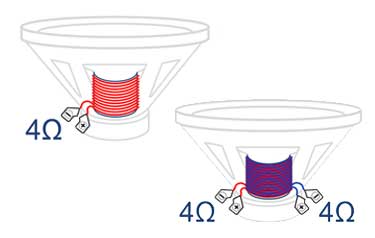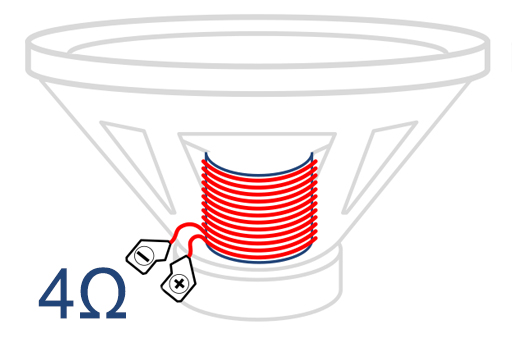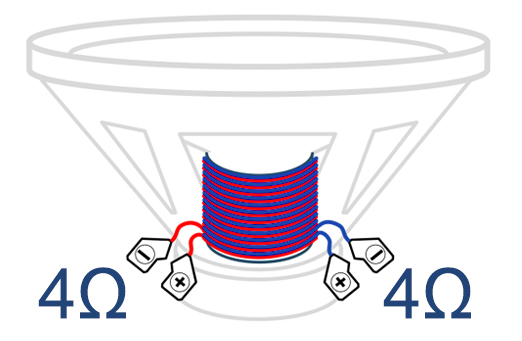Free Shipping*
Lower 48. Orders over $100.
2 Year Warranty
On all our radios.

Your cart is currently empty.

If you have spent any time researching subwoofers you have likely noticed SVC, DVC, single voice coil, or dual voice coil. We will explain what the differences are between these two types of subwoofers and how it impacts your subwoofer and amplifier selection.
Here's the somehwat, but non-scientific version. The voice coil is the part of the speaker that makes the speaker cone move up and down. The cone moves up and down, it moves air, moving air makes sound.
The voice coil in a subwoofer is wound magnetic wire that is in a cylinder shape. Typically, the more wire that is wound means a larger voice coil and more surface area. More surface area means it can dissipate more heat, which means it can handle more power. When the music signal comes from the amplifier, the electricity energizes the magnetic wire on the voice coil. When that magnetic wire receives a charge, it creates a magnetic field, and that magnetic field is the same polarity of the magnetic on the back of the speaker. This creates a repel action which moves the cone forward, which moves air and makes sound. It does all of this really, really fast at different frequencies and creates bass from subwoofers
When you see a single voice coil subwoofer, that means that there is a single set of positive and negative ends to the magnetic wire, and there is one coil. The subwoofer will have one set of terminals, one positive and one negative. The voice coil typically has 1 ohm, 2 ohm, or 4 ohm impedance.

A dual voice coil subwoofer means you have two coils of magnetic wire intertwined, working together. So instead of taking one wire and coiling it up, you take two wires and coil it up. It's not that one coil is at the top and the other is at the bottom, they are coiled together so if you looked at it, and you called one coil, "A" and the other "B" if you went up the entire coil, you would see A, B, A, B, A, B, alternating. Dual voice coil subwoofers have two sets of terminals and you want to ensure that you power up both of them to protect your subwoofer and maximize performance. You will find the impedance ratings on dual voice coil subwoofers as 2 ohm DVC, 4 ohm DVC, and 8 ohm DVC.

No. Whether it is a single voice coil or dual voice coil doesn't improve or harm anything. It is simply the way the coil is spun. The most important thing is whether or not the subwoofer model that you want is available in multiple impedance options.
For example, the JL Audio W0v3 subwoofers only come in a single 4 ohm voice coil. This means, you need to look at the amplifiers rating at 4 ohms if you only plan to run one subwoofer. So, because you can only wire a single subwoofer with a single 4 ohm voice coil to a 4 ohm load, you are likely buying a 500 watt amp to power a 300 watt RMS subwoofer. You are only getting 250 watts out of your "500 watt" amplifier because you need to use the 4 ohm rating, not the 2 ohm rating.
Now, let's take a look at the JL Audio W1v3 subwoofers which are available in both 2 ohm SVC, and 4 ohm SVC. The 10" subwoofer is rated at 300 watts. If I am running a 2 ohm SVC verson of the 10" W1 subwoofer, I can run a 250 watt amplifier at 2 ohms and get 250 watts RMS out of the amplifier. So, because the W1 is offered in multiple impedances, I can get a better subwoofer, a less expensive amplifier, and the amplifier will put out the same amount of power. Yes the subwoofer is slightly more expensive, but the 2 ohm SVC allows for more efficient use of the amplifiers power when running only 1 subwoofer.
Whether or not you choose to go with 2 ohm or 4 ohm subwoofers will depend on your amplifier. If your amplifier is 1-ohm stable, you can wire your subwoofers to a 1-ohm load. If not, you will likely need to wire your subwoofers to a 2-ohm load. If you are briding and amplifier, you will likely need to wire them to a 4 ohm load.
For full details on how to wire your subwoofers, check out our subwoofer wiring wizard.
Copyright © 2026 ClassicCarStereos.com